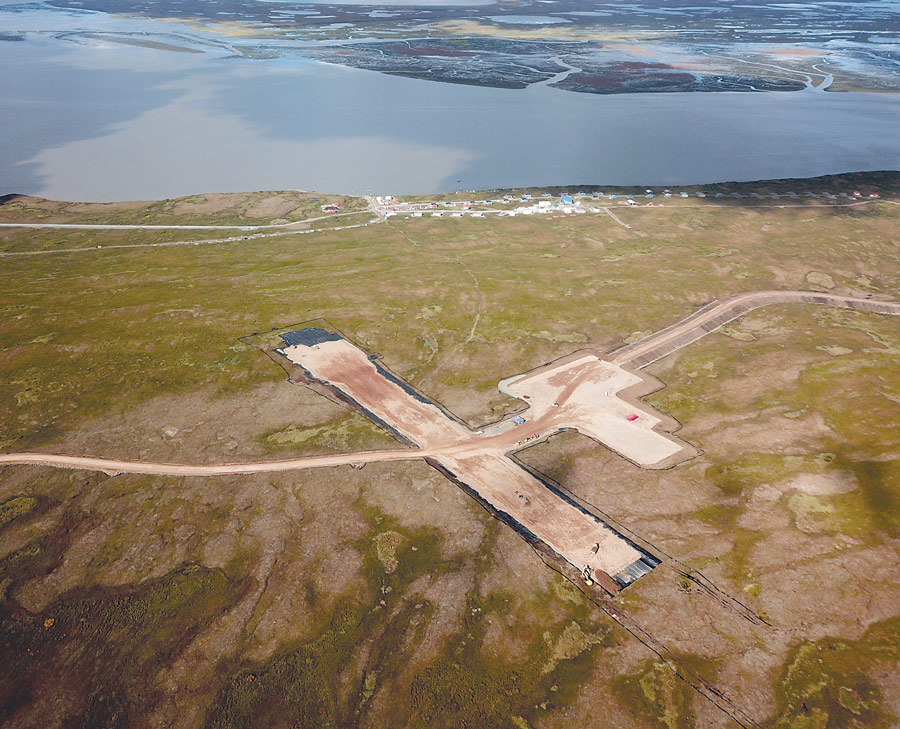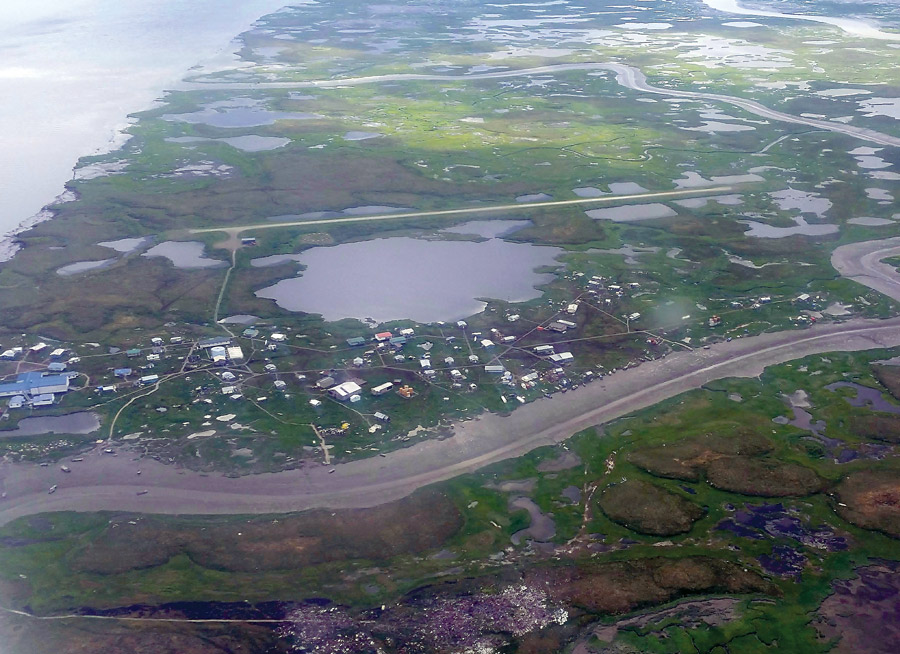
Update

Photo courtesy of Matt Schram, project superintendent for QAP
Photo courtesy of Matt Schram, project superintendent for QAP

nyone who has driven more than a handful of miles in Alaska knows pavement does not do well in the North. Despite nonstop efforts from the Alaska Department of Transportation & Public Facilities, or DOT&PF, to keep highways in working order, frost heaves, erosion, subsidence, and other natural subsurface occurrences are perpetually turning the state’s highways into obstacle courses. Drivers here are well acquainted with the temporary loss of vehicular control that occurs when they suddenly hit an unexpected bulge or pothole. It can be dangerous if they’re moving quickly, especially if the road is icy.
Now imagine what pilots experience when they land a plane at an airport plagued by the same conditions.
“The larger regional-hub certified airport runways serve high-performance jet aircraft,” says Roger Maggard, statewide airport development manager with the DOT&PF. “So, they’re sensitive to minor variations in the runway surface that wouldn’t necessarily cause problems to somebody landing in a Cessna 206—but for these large high-performance aircraft going fast, it does cause problems.”
Similar to the state’s highways, Maggard says, runways present transportation officials with a perennial struggle to stay ahead of “ice-rich soils that are melting.”
Maggard oversees the Airport Improvement Program, or AIP, which ranks and prioritizes needed upgrades at airports across a state where many communities are inaccessible by road and thus reliant on aviation to maintain their connection to the rest of the world. “What we want to achieve is to keep our airports in good, safe, operational condition,” he says.
After all the proposals have been examined and scored, the board ranks them to determine which projects to undertake in coming months, based on priority and budget availability. Then they put the projects out to bid. Maggard says once the low bid is selected, the grant application is prepared for the FAA. Final approval for a project comes from the office of the Secretary of Transportation.
Maggard points to the airports at Nome, Kotzebue, Utqiagvik, and Bethel as examples of important regional hubs that are beset by subsurface problems.
“There’s a lot of permafrost in the area, and it’s impacting all infrastructure. Especially when you put pavement on it,” he explains. “Pavement’s a dark color and it absorbs radiation and tends to increase the likelihood of transmitting that heat deeper into the ground, accelerating the ice melting in permafrost areas.”
DOT airport contracts are currently funding more than $100 million in repairs and upgrades, ranging from routine runway rehabilitation in Nightmute to the airport in Newtok which, like the town itself, is being moved to drier ground. The latter, Maggard says, is “a project that illustrates the impacts of climate warming.”

Photo courtesy of Roger Maggard, Alaska Department of Transportation & Public Facilities
“We milled the entire apron, regraded it, and then we used a process that was new to this area. The first time they’ve used it in the northwest region,” says Matt Schram, a project superintendent for QAP.
The process is called foamed asphalt base stabilization. “We actually ground the sub-base up and injected foamed asphalt and cement. It’s kind of a way to stabilize the base. And then we paved on top of that. That was pretty much the project in a nutshell.”
Schram says foamed asphalt is a technique employed to absorb ground movement from thawing permafrost. “You have a grinding machine that’s hooked to a water tanker and also a hot oil tanker. When you actually inject the asphalt into the aggregate, the oil is at 350º Fahrenheit. Once that hot oil hits the water, they call it foaming. It expands. And that process, once it sets up, makes a very durable, yet flexible, base course to pave on.”
This process recycles existing materials into new roads, runways, and other paved surfaces. But additional aggregate is still needed, Schram says. “There’s no aggregate source in Kotzebue. So, we brought up all our aggregate for asphalt D-1 from Nome.”
This points to the logistical challenges facing any contractor bidding on a remote airport job in Alaska. Getting equipment and supplies to work sites is a major endeavor in itself. Most airports are near rivers or the coast and can be reached by barge during summer months. This is what QAP did in the summer of 2020 in preparation for last summer’s work, Schram says. “We barged all that in and staged it last summer into fall. But as far as work on the project, it was a one-year project.”
Maggard says while most airports can be accessed via nearby waterways, a few can’t.
“In cases where it’s not located by a river, it gets a lot more complicated,” he says. “In extreme cases, you might have to take it overland—or you might even have to fly.”
Flying gravel to a construction site is extremely expensive. Fortunately, he said, these cases are the exception.
Engineer’s estimate: between $1 million and $2.5 million. Award pending.
Awarded to GeoTek Alaska Inc. at $1,498,742.
Awarded to Knik Construction Co. Inc. at $14,085,572.
Engineer’s estimate: between $20 million and $30 million. Award pending.
Awarded to Knik Construction Co. Inc. at $33,822,092.
Awarded to GeoTek Alaska Inc. at $167,400.
Bids rejected. Going to rebid.
Awarded to Denali Drilling Inc. at $165,850.
Awarded to Brice, Inc. at $6,487,530.
Awarded to Olgoonik Construction Services at $6,683,000.
Awarded to Cruz Construction, Inc. at $22,686,977.
Awarded to Cruz Construction, Inc. at $5,556,860.
Awarded to ASRC Civil Construction at $5,339,125.
Awarded to Kikiktagruk Inupiat
Corporation Construction/Drake Construction Joint Venture at $11,374,249.
Awarded to Brice, Inc. at $10,686,279.
Awarded to Jolt Construction and Traffic Maintenance, Inc. at $119,000.
Award pending.

Photo courtesy of Roger Maggard, Alaska Department of Transportation & Public Facilities
“We had to ship materials via barge out of Anchorage to Stebbins, and obviously had to fly some guys and material into the airport as well,” he says. “Just getting from the barge landing to the airport can be challenging. You don’t have the resources or equipment in place like you do in a road-accessed area.”
While on site, Jolt’s crew had the additional concern of maintaining safe pandemic practices in order to protect the community.
“You’re trying to limit interactions” with local residents, Cole says. But “at the same time you’re in a new place that you don’t know anything about. So, you do need local help and support, and that makes it challenging.”
Cole said the Stebbins job went smoothly and credited a skilled and experienced workforce with allowing the company to be done with the onsite work in a matter of days.
“If we had never done a project like this before, it wouldn’t be as efficient,” he says. “We’d be a lot slower.”
The contract in Stebbins came in at under $120,000, which makes it one of the smallest DOT airport upgrades of 2021. Most cost much more—some jobs at Alaska’s remote airports, such as upgrades at Nome and Ekwok, are budgeted at $25 million or more. Almost all of the funding comes from the federal Airport Improvement Program, under the Federal Aviation Administration. According to the DOT&PF’s Maggard, the federal government pays nearly 94 percent of the costs, with the state picking up the rest.
“The match ratio is so favorable that the Legislature has been willing to provide the match for all the projects that we can get federal funding for,” Maggard says.
Maggard says many of the problems at remote airports that require attention result from permafrost degradation. As air temperatures across Alaska slowly increase, soils are warmed and permafrost thaws, wreaking havoc on infrastructure.
“Every airport that’s built in the northern part of the state is seeing that problem,” he says.
Maggard says Alaska’s airport woes are an unending battle. “As soon as you get one spot fixed, next year something else subsides. Most airports, especially paved airports built in the northern part of the state, are seeing that problem.”
With climate change speeding the process a bit more each year, he doesn’t anticipate the situation getting better. “It’s a definite problem,” he says. One “that’s probably not going to do anything but get worse as temperatures rise.”